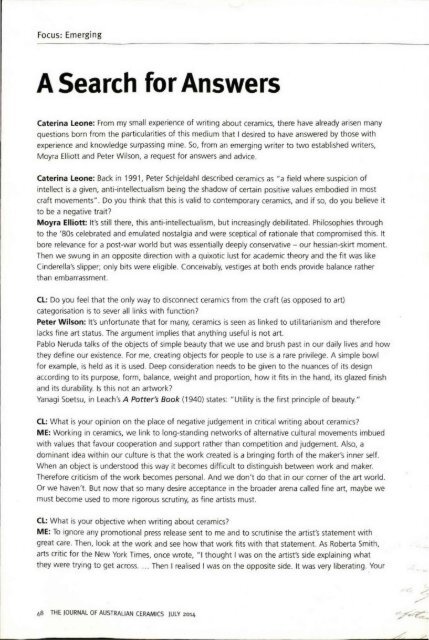The Journal of Australian Ceramics Vol 53 No 2 July 2014
Create successful ePaper yourself
Turn your PDF publications into a flip-book with our unique Google optimized e-Paper software.
Focus: Eme rgin g<br />
A Search for Answers<br />
Caterina Leone: From my small experience <strong>of</strong> writing about ceramics, there have already arisen many<br />
questions born from the particularities <strong>of</strong> this medium that I desired to have answered by those with<br />
experience and knowledge surpassing mine. So, from an emerging writer to two established writers,<br />
Moyra Elliott and Peter Wilson, a request for answers and advice.<br />
Caterina Leone: Back in 1991, Peter Schjeldahl described ceramics as "a field where suspicion <strong>of</strong><br />
intellect is a given, anti-intellectualism being the shadow <strong>of</strong> certain positive values embodied in most<br />
craft movements"'. Do you think that this is valid to contemporary ceramics, and if so, do you believe it<br />
to be a negative trait?<br />
Moyra Elliott: It's still there, this anti-intellectualism, but increasingly debilitated. Philosophies through<br />
to the 'BOs celebrated and emulated nostalgia and were sceptical <strong>of</strong> rationale that compromised this. It<br />
bore relevance for a post-war world but was essentially deeply conservative - our hessian-skirt moment.<br />
<strong>The</strong>n we swung in an opposite direction with a quixotic lust for academic theory and the fit was like<br />
Cinderella'S slipper; only bits were eligible. Conceivably, vestiges at both ends provide balance rather<br />
than embarrassment.<br />
CL: Do you feel that the only way to disconnect ceramics from the craft (as opposed to art)<br />
categorisation is to sever all links with function?<br />
Peter Wilson: It's unfortunate that for many, ceramics is seen as linked to utilitarianism and therefore<br />
lacks fine art status. <strong>The</strong> argument implies that anything useful is not art.<br />
Pablo Neruda talks <strong>of</strong> the objects <strong>of</strong> simple beauty that we use and brush past in our dai ly lives and how<br />
they define our existence. For me, creating objects for people to use is a rare privilege. A simple bowl<br />
for example, is held as it is used. Deep consideration needs to be given to the nuances <strong>of</strong> its design<br />
according to its purpose, form, balance, weight and proportion, how it fits in the hand, its glazed finish<br />
and its durability. Is this not an artwork?<br />
Yanagi Soetsu, in Leach's A Potter's Book (1940) states: "'Utility is the first principle <strong>of</strong> beauty."'<br />
CL: What is your opinion on the place <strong>of</strong> negative judgement in critical writing about ceramics?<br />
ME: Working in ceramics, we link to long-standing networks <strong>of</strong> alternative cultural movements imbued<br />
with va lues that favour cooperation and support ra ther than competition and judgement. Also, a<br />
dominant idea within our culture is that the work created is a bringing forth <strong>of</strong> the maker's inner self.<br />
When an object is understood this way it becomes difficult to distinguish between work and maker.<br />
<strong>The</strong>refore criticism <strong>of</strong> the work becomes personal. And we don't do that in our corner <strong>of</strong> the art world.<br />
Or we haven't. But now that so many desire acceptance in the broader arena called fine art, maybe we<br />
must become used to more rigorous scrutiny, as fine artists must.<br />
CL: What is you r objective when writing about ceramics?<br />
ME: To ignore any promotional press release sent to me and to scrutinise the artist's statement with<br />
great care . <strong>The</strong>n, look at the work and see how that work fits with that statement. As Roberta Smith,<br />
arts critic for the New York Times, once wrote, "'I thought I was on the artist's side explaining what<br />
they were trying to get across .... <strong>The</strong>n I realised I was on the opposite side. It was very liberating. Your<br />
48 THE JOURNAL Of AUSTRALIAN CERAMICS JULY <strong>2014</strong>

















